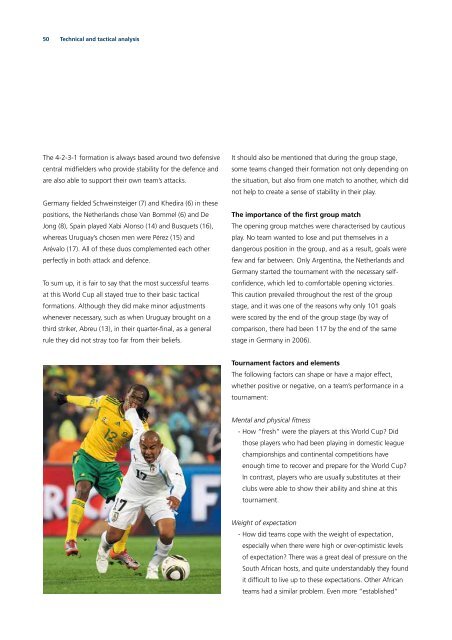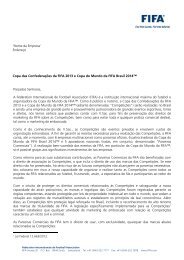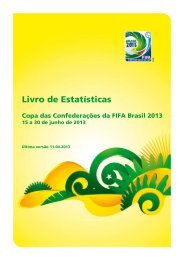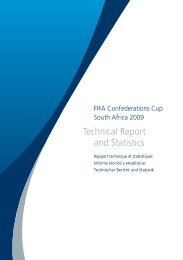You also want an ePaper? Increase the reach of your titles
YUMPU automatically turns print PDFs into web optimized ePapers that Google loves.
50 Technical and tactical analysis<br />
The 4-2-3-1 formation is always based around two defensive<br />
central midfi elders who provide stability for the defence and<br />
are also able to support their own team’s attacks.<br />
Germany fi elded Schweinsteiger (7) and Khedira (6) in these<br />
positions, the Netherlands chose Van Bommel (6) and De<br />
Jong (8), Spain played Xabi Alonso (14) and Busquets (16),<br />
whereas Uruguay’s chosen men were Pérez (15) and<br />
Arévalo (17). All of these duos <strong>com</strong>plemented each other<br />
perfectly in both attack and defence.<br />
To sum up, it is fair to say that the most successful teams<br />
at this World Cup all stayed true to their basic tactical<br />
formations. Although they did make minor adjustments<br />
whenever necessary, such as when Uruguay brought on a<br />
third striker, Abreu (13), in their quarter-fi nal, as a general<br />
rule they did not stray too far from their beliefs.<br />
It should also be mentioned that during the group stage,<br />
some teams changed their formation not only depending on<br />
the situation, but also from one match to another, which did<br />
not help to create a sense of stability in their play.<br />
The importance of the fi rst group match<br />
The opening group matches were characterised by cautious<br />
play. No team wanted to lose and put themselves in a<br />
dangerous position in the group, and as a result, goals were<br />
few and far between. Only Argentina, the Netherlands and<br />
Germany started the tournament with the necessary selfconfi<br />
dence, which led to <strong>com</strong>fortable opening victories.<br />
This caution prevailed throughout the rest of the group<br />
stage, and it was one of the reasons why only 101 goals<br />
were scored by the end of the group stage (by way of<br />
<strong>com</strong>parison, there had been 117 by the end of the same<br />
stage in Germany in 2006).<br />
Tournament factors and elements<br />
The following factors can shape or have a major effect,<br />
whether positive or negative, on a team’s performance in a<br />
tournament:<br />
Mental and physical fi tness<br />
- How “fresh” were the players at this World Cup? Did<br />
those players who had been playing in domestic league<br />
championships and continental <strong>com</strong>petitions have<br />
enough time to recover and prepare for the World Cup?<br />
In contrast, players who are usually substitutes at their<br />
clubs were able to show their ability and shine at this<br />
tournament.<br />
Weight of expectation<br />
- How did teams cope with the weight of expectation,<br />
especially when there were high or over-optimistic levels<br />
of expectation? There was a great deal of pressure on the<br />
South African hosts, and quite understandably they found<br />
it diffi cult to live up to these expectations. Other African<br />
teams had a similar problem. Even more “established”







